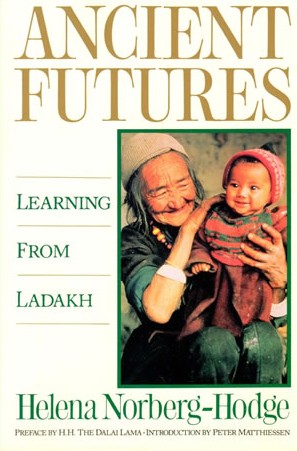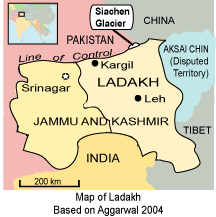Location. The people of Ladakh live in very high mountain valleys between the Himalaya and Karakoram ranges in the northern Indian state of Jammu and Kashmir. Ladakh is divided into the primarily Muslim district of Kargil and the primarily Buddhist district of Leh, which is the focus of most of the literature on Ladakhi peacefulness. The 2001 census counted 117,000 people in Leh District. The Kargil District is also considered to be quite peaceful, according to a report in 2012.

Economy. The Ladakhi economy has traditionally been based on small farms and on herding, but since the 1970s, tourism and other outside sources of income have also become available. These economic changes have tended to weaken traditional patterns of village cooperation, causing difficulties for farmers who have a hard time paying for assistance.
Beliefs that Foster Peacefulness. While some scholars such as Harvey (1983) argue that Ladakhi peacefulness rests primarily on inner resources and calmness, personal characteristics that are fostered by their Buddhist beliefs, Pirie (2007) disagrees. She maintains that the monks and religious practices in the villages are quite disconnected from the political, social, and moral order. In the village she studied, the Ladakhi strongly disapproved of public displays of anger, disharmony, or discontent. They idealized a peaceful, united, harmonious community, free of conflict and anger. Conflict, they felt, is a manifestation of a society that is degenerate—though they recognized the failings in their own community.
Avoiding and Resolving Conflict. One feature of their social life that often serves to prevent conflicts from occurring is that third party observers to economic dealings—people who just happen to be nearby—will usually act as arbiters, intervening to assist two parties when they make an agreement. When conflicts do arise between villagers, they are resolved by the elected head of the village, called the goba, who listens to both sides of the case and makes a decision as to which of the parties may have to pay a fine or make restitution. If the goba can’t resolve a conflict, the matter is passed along to a yulpa, a meeting of the village men. While they may vote, they rarely do so, since they are normally able to reach consensus decisions. Part of their reason for trying to settle disputes locally is their desire to avoid outside interference in village affairs. The people of Zanskar, a valley in Ladakh, are especially eager to settle disputes among themselves, according to a book published in 2015.
Gender Relations. Husband and wife relations are characterized by cooperation and affection. Though the husband is usually the dominant partner, the couple may easily separate and divorce. In traditional Ladakhi society the oldest son would inherit the house of the parents; younger brothers, in order to gain a share of the inheritance, could also marry the wife of their oldest brother. Each man was equally responsible for all of the children, jealousy was rare, and the adults loved all the children equally. The practice of polyandry, and management of the household economy, gave a lot of power and satisfaction to the wives. But traditional patterns of polyandry have mostly disappeared in Ladakh today, and women are being marginalized by modernization. That said, however, the reporter for a news story in 2012 observed a very strong sense of gender equality and strength of the women in remote villages of Ladakh and another in 2015 described a woman who founded a trekking business staffed by rural Ladakhi women. Furthermore, Ladakhis have a long history of harmonious, peaceful inter-faith marriages and good community relations between Buddhists and Muslims, a tradition, however, that is fraying as articles in 2011, 2012 and 2014 have suggested.

Raising Children. Ladakhi babies are cared for constantly and lovingly, mostly by the mothers but also by others in the family. As children grow older, they are involved with all activities and are rarely separated from the family. Adults are infinitely patient with children, suffering their interruptions without complaint. Despite the constant affection and attention that children receive, they do not appear to become spoiled. They grow up as part of a giving and receiving system of human relationships, and while they are still quite young they will share their own food spontaneously with their peers.
Sense of Self. The Ladakhis normally seem to be irrepressibly happy—they do not retreat into themselves due to sorrows, fears or insecurities. They have a strong sense of self and a deeply-rooted self-respect, combined with a noticeable lack of pride. They also have a strong sense of their place on earth, a bond developed through daily contact with their natural environment, and an equally firm feeling for their place in human society. Their traditional society has consisted of extended families, small, interconnected communities, and mutual interdependence. Their contentment and peace of mind do not rest on external circumstances, but rather on their own inner resources and calmness.
Cooperation and Competition. Because of the harsh mountain environment of Ladakh, helpfulness and cooperation among families is essential for survival. The Ladakhis establish cooperative groups called phasphuns, in which several unrelated families maintain alliances of friendship, cooperation, and helpfulness. If both parents in a family would die, other adults in the phasphun would adopt the young children. If a family separates, the other members of the phasphun make a fair division of the property. The families in the phasphun usually live in the same village, participate in group religious ceremonies, and worship a common god, though they are not necessarily neighbors and are often not related. The mutual cooperation is carried out under the aegis of the ruling deity, who provides the link for the six to ten families in the group.
Social Control. When individuals violate social norms or threaten the life of the community, the ultimate form of social control is ostracism, though it is very infrequently used. If the person does not cease the offending behavior, the lamas may stop serving the religious needs of the offender, which is highly demoralizing to the Ladakhis. No one may visit the offender; no one will help the offender or the family in any endeavor; no one offers or accepts food from the offender; and there are no possibilities of marriage alliances with other families. This harsh punishment can only be relieved when the offender seeks the pardon from the village civil and religious leaders.
 Strategies for Avoiding Warfare and Violence. The Ladakhis are known for their patience, tolerance, honesty, and truthfulness with one another. They similarly tend to deal with outsiders in a straightforward, peaceful manner. However, the massive presence of the Indian Army in Ladakh may harm the traditional nonviolence of the district.
Strategies for Avoiding Warfare and Violence. The Ladakhis are known for their patience, tolerance, honesty, and truthfulness with one another. They similarly tend to deal with outsiders in a straightforward, peaceful manner. However, the massive presence of the Indian Army in Ladakh may harm the traditional nonviolence of the district.
But How Much Violence Do They Really Experience? The Buddhist Ladakhis are normally very peaceful: major crimes are unknown, aggression and arguments rare, and traditional social systems minimize deviant behavior such as lying, stealing, and back-biting. One long-time observer and resident in Ladakh, Helena Norberg-Hodge, indicates that, in one village, people told her that “there has been no fighting in the village in living memory.” (1991 p.46) The 1979 political division of Ladakh into the Muslim Kargil and Buddhist Leh districts, plus the subsequent insensitivity in handling Muslim and Buddhist difficulties, led to some inter-community Muslim-Buddhist violence between 1989 and 1993. Since then the rifts appear to have healed. An article in 2014 analyzed in more detail the strife between the Buddhist and Muslim communities in Ladakh.
More Resources in this Website:
- The excessive consumption of alcohol threatens Ladakhi society.
- A tourist festival celebrates traditional Ladakhi harmony and peacefulness.
- The intangible cultural heritage of Ladakh is being preserved by museums.
- Ladakhis are taking a strong interest in utilizing solar energy, as articles in 2013 and 2014 demonstrate.
- A Ladakhi man tried to counteract the effects of global climate change with artificial glaciers, but another man develops ice stupas instead.
Sources in Print: Aggarwal 2004; Harvey 1983; Hay 1999; Mann 1972, 1986; Norberg-Hodge 1991; Pirie 2007; Rizvi 1996
Sources on the Web: Official Website of the District of Leh (Ladakh); Wikipedia (English Version); The Ladakh Project; Facebook Ladakh page
Updates—News and Reviews:
Selected Recent Stories
December 17, 2015. Boycott in Ladakh
September 10, 2015. Ladakhi Village Electrified
May 7, 2015. Progress among the Ladakhis
March 26, 2015. Is Baltistan Peaceful?
All Stories
All stories in this website about the Ladakhis are listed in the News and Reviews Subject Listing
